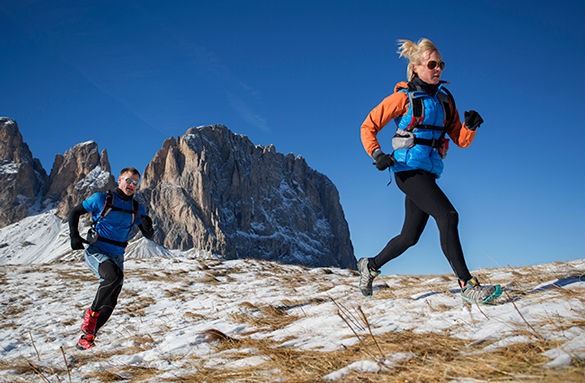
Key Points to Remember
- If you are working with a client who is training for events at high altitude, understanding the effects of high altitude on the body and, importantly, how to mitigate those effects is essential for helping your clients reach their goals.
- At high altitude, oxygen transport from the atmosphere into the lungs and then into the blood is compromised due to lower barometric pressure, not because of less oxygen.
- While it is true that some favorable physiological adjustments occur after several days, altitude acclimatization requires closer to two weeks. Therefore, if performing at altitude is of concern, allow for a two-week acclimation period to achieve the best results.
- High-intensity interval training (HIIT keeps clients’ heart rates elevated for a majority of the sessions, which not only challenges their cardiovascular systems, but also fosters the mental toughness required to push through the difficult sensations that will likely be experienced at altitude.
- Even with full acclimatization, the reality is that performance for a given event will be decreased at altitude when compared to sea level.
Exercise is stress. Add high altitude into the mix, and you’ve got a whole new challenge for the body. If you are working with a client who is training for events at high altitude, understanding the effects of high altitude on the body and, importantly, how to mitigate those effects is essential for helping your clients reach their goals.
High altitude is generally considered anything greater than 7,000 feet above sea level, explains Lance Dalleck, Ph.D., assistant professor of exercise and sport science at Western State Colorado University. To give this some context, ACE headquarters, located in San Diego, Calif., is at a whopping 62 feet, the Olympic Training Center in Colorado Springs is at 6,250 feet, and the highest peak in the lower 48 states, Mount Whitney, is at 14,505 feet. A few other notable peaks elsewhere in the world include the Matterhorn at 14,692 feet, Mt. Kilimanjaro at 19,341 feet, and, of course, Mt. Everest at 29,029 feet (which is almost flying altitude!).
This year, I spent a considerable amount of time preparing to climb Mt. Kilimanjaro. Understanding the effects of high altitudes on the body, and learning what I could do to improve my chances of making a successful summit became important parts of my training. I began this quest by tracking down the latest scientific evidence on high-altitude training, as well as some practical tips that would help me along my trip to the roof of Africa. The purpose of this article is to share with you what I learned—what the research and the experts have to say—so you can help adventure-minded clients achieve their goal of climbing to great heights.
Effects of Altitude on the Body
Before designing a high-altitude training program, it’s important to understand the effects of altitude on the body. At high altitude, oxygen transport from the atmosphere into the lungs and then into the blood is compromised due to lower barometric pressure (not because of less oxygen, which we’ll address in the myths section below). Because of the decreased amount of oxygen available in the blood, the body may experience several side effects, which are referred to as altitude sickness or acute mountain sickness (AMS). These symptoms include:
- Fatigue
- Difficulty breathing
- Elevated heart rate
- Headache
- Nausea
- Dizziness
- Trouble sleeping
Myths About Altitude Training
Before discussing some ways to mitigate these symptoms and have a successful experience at high altitude, Dr. Dalleck addresses some of the myths and misconceptions about high altitude.
Myth #1: There is less oxygen at higher altitude.
Whether you are at sea level or at an elevation of 10,000 feet, oxygen makes up 20.93% of the air you breathe (Epthorp, 2014). However, there is a lower barometric pressure (atmospheric pressure) at higher altitudes, which leads to a decreased partial pressure of oxygen (the amount of oxygen in arterial blood). Stated simply, moving oxygen from the atmosphere into the lungs and bloodstream is more difficult the higher you go. For this reason, there is less oxygen getting into the body even though the same amount of oxygen is available in the atmosphere. When a person remains at high altitude, however, thebody compensates over time by producing more hemoglobin (the oxygen-carrying molecule in the blood).
According to Dr. Dalleck, the persistent belief that there is less oxygen at higher altitude is likely because “it is easier to say ‘there’s less oxygen the higher up you go’ instead of ‘decreased performance at altitude stems from the lower barometric pressure and concomitant decreased partial pressure of oxygen.’”
Myth #2: Altitude training improves sea-level performance.
Although we know that exercise performed at high altitude can increase overall maximal oxygen uptake (VO2max), much of the early research on the use of altitude training in improving performance at sea level didn’t include the use of a control group (a group who stayed at sea level and performed the same program as the test group) (Biggs et al., 2017). As a result, when the research did indicate an improvement in an altitude-trained group, it was challenging to equate that improvement to the altitude training alone. Could the participants have simply improved their overall fitness? Yes, of course. But without a control group doing the same training regimen at sea level, that conclusion is not concrete.
Additionally, “Many studies throughout the 1980s and 1990s didn’t account for iron status of participants,” says Dr. Dalleck. Researchers have since suspected that those who didn’t respond to attitude training may have been anemic. Iron is a key mineral required for sufficient red blood cell production, so it is very possible that anemia could have been to blame for some of the lack of improvement seen after a high-altitude training protocol. “Almost all altitude-related studies now have participants take an iron supplement to avoid this issue,” confirms Dr. Dalleck.
Myth #3: To fully acclimate to altitude before an athletic event, arrive three to four days in advance.
“Up to 80% of individuals are likely to experience some degree of AMS in the first several days of altitude exposure,” says Dr. Dalleck, so it is important to know the progression of AMS symptoms and their severity. As noted above, AMS can affect nutrition and sleep, which means most people will need more than four days to reestablish proper sleep and nutrition patterns, and to begin to create more mitochondria for increased oxygen transport.
While it is true that some favorable physiological adjustments occur after several days, according to Dr. Dalleck altitude acclimatization requires closer to two weeks. Therefore, if performing at altitude is of concern, allow for a two-week acclimation period to achieve the best results.
Tips for Preparing for Events at Altitude
To help you and your clients fully prepare for an event at high altitude, we’ve tapped the expertise of two ACE Certified Professionals who have experience taking their athletes to the highest levels (literally).
Amy Reilly, ACE Certified Personal Trainer and owner of Renew You Colorado in Boulder, Colo., explains that staying hydrated is important for performing well at high altitude, because more fluid is lost due to increased breathing and sweat rates. “Add in competition,” says Reilly, “and you’re at a much greater risk of becoming dehydrated.” She also recommends consuming electrolytes for endurance events at higher altitude.
In addition to training clients for their specific activities or events (such as hiking or running races), Reilly includes plyometrics and other cardiovascular high-intensity training to prepare her clients physically for exercising at higher altitude. Because working at higher altitudes occurs in a hypoxic environment, she uses high-intensity interval training (HIIT), which has been shown to improve VO2max. These types of workouts keep clients’ heart rates elevated for a majority of the sessions, which not only challenges their cardiovascular systems, but also fosters the mental toughness required to push through the difficult sensations that will likely be experienced at altitude.
“Even the most well-trained athletes can experience altitude sickness,” Reilly reminds us, so be sure you are aware of the signs and symptoms as described above. If you or your clients are at high altitude and begin to experience signs of AMS, the best action is to quickly and safely get to a lower altitude.
For Mike Deibler, ACE Certified Personal Trainer and owner of San Diego Premier Training, training his clients for high-altitude Spartan races takes on a different look because his gym is located at sea level in southern California.
“Although it may be the best system for adapting to altitude training, the ‘live high, train low’ philosophy that many athletes use to improve their athletic performance is not realistic for others,” says Deibler.
Instead, Deibler includes exercises to improve his clients’ breathing patterns and to train respiratory muscles, which can be incredibly effective for preparing the body for altitude. Simple strategies include nasal breathing during low- or moderate-intensity exercise, breath-holding drills and respiratory muscle training. He suggests spending a few minutes each day inhaling through a straw to improve conditioning of the inspiratory muscles to ensure they do not become a limiting fatigue factor during the high-altitude event.
“If nothing else, it helps clients learn to stay calmer when they are having a hard time getting air in,” explains Deibler. “So there definitely is a psychological aspect, as well.”
When it comes to race-day pacing for a specific high-altitude event, it is advisable to adjust the pace accordingly for the altitude. Even with full acclimatization, the reality is that performance for a given event will be decreased at altitude when compared to sea level. Too often, says Deibler, “individuals try to replicate a sea-level performance only to blow up midway through a race.”
Additionally, altitude events often take place on challenging terrain with uneven footing and steep ascents and descents. Practicing on these terrains prior to coming to altitude can help clients prepare both mentally and physically for the event so that the first time they experience the trail isn’t on race day.
Here are a few more tips from Dr. Dalleck for sea-level athletes who want to perform their best at altitude:
- Give yourself 10 to 14 days to acclimatize prior to the activity, race or competition. This timeframe will permit 80 to 90% of the positive physiological adaptations to occur that will contribute to a successful performance.
- If you’re not able to give yourself the two weeks to fully acclimate, Dalleck suggests arriving at least 24 hours before the event. This will help to mitigate the side effects of AMS and ensure that performance will not be as negatively affected.
- Abstain from drinking alcohol when at altitude.
- Eat several small meals during the day (rather than two to three large meals).
Conclusion
Helping your clients perform at their best is important for your success as a health and fitness professional. For events taking place at altitude, in particular, proper preparation becomes paramount. Whether you or your clients are racing an Xterra off-road triathlon at elevation, doing a weekend hike with the family or climbing to the roof of Africa, understanding the effects of high altitude and designing an effective program based on the guidelines presented here are essential. Take the advice of our ACE professionals—I know I will.
References
Epthorp, J.A. (2014). Altitude training and its effects on performance. Journal of Australian Strength & Conditioning, 14, 22, 1, 78-89.
Biggs, N.C. et al. (2017). Effects of simulated altitude on maximal oxygen uptake and inspiratory fitness. International Journal of Exercise Science, 10, 1, 127-137.

 by
by 


